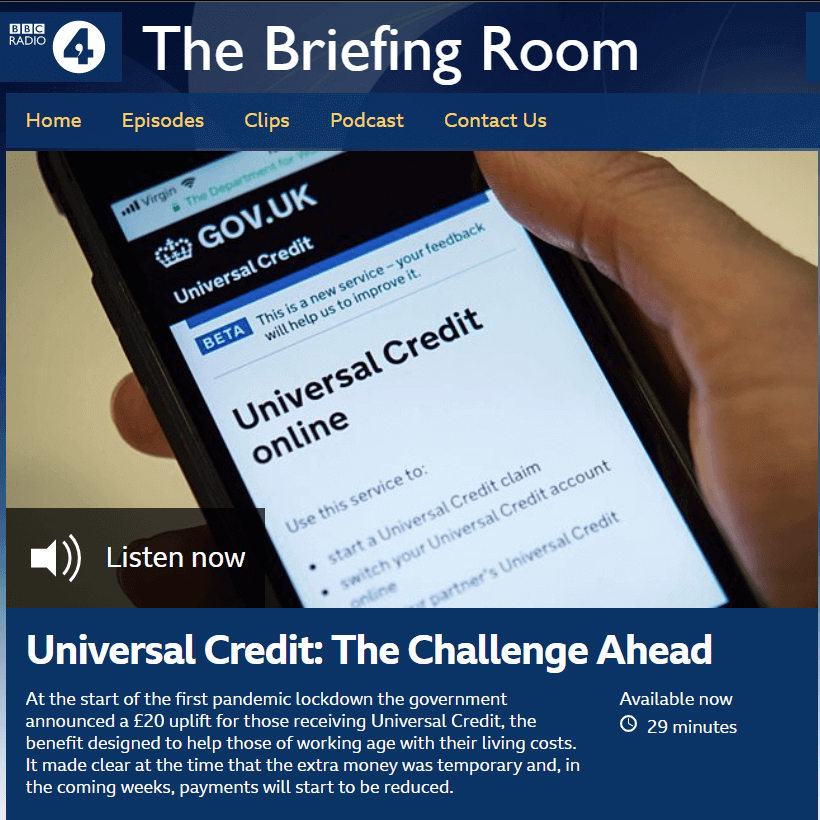Policy alternatives to the £20 cut to Universal Credit

The government is set to remove the £20 weekly uplift to Universal Credit from September 2021, reducing the incomes of six million people on Universal Credit by over £1,000 per year.
Yesterday BBC Radio 4’s The Briefing Room, hosted by David Aaronovitch, gave an excellent overview of Universal Credit, and the impact this cut is likely to have on all of those affected.
Deven Ghelani from Policy in Practice spoke, along with Gemma Tetlow of the Institute for Government, Fran Bennett from Oxford University’s Department of Social Policy and Intervention, and Tom Waters from the Institute for Fiscal Studies. Deven discussed the policy choices faced by the Secretary of State and the Chancellor, and alternatives to the cut to Universal Credit. You can listen to the programme here.
The furlough scheme gave much more money to people who weren’t able to work. That highlights a recognition that social security is insufficient for most people to live on for a long period of time. The pandemic highlighted that misfortune is quite random. People who have been stuck on social security for a long time, and those who have been unable to work, have suffered misfortune. It’s not laziness or lack of attitude – two thirds of people on Universal Credit are either in work or not expected to work.
It really comes down to value judgements by the Chancellor around who is deserving and who isn’t. Social security has effectively been cut to the bone and then cut some more, so that alone gives reason to keep the £20 uplift in place.
Deven Ghelani, Director and Founder, Policy in Practice
Help for people on Universal Credit to plan for the loss of the £20 uplift
Policy in Practice’s free Benefit Calculator now shows users their likely Universal Credit award with or without the £20 uplift, allowing people to toggle between the two options. This helps people to plan for the reduction in income.
As default, we have removed the £20 a week uplift from Universal Credit award calculations. This is because people who make new claims for Universal Credit will receive their first payment next month after the uplift is expected to be removed. If you wish to see the £20 a week uplift included, click the link on the results page to add it in.
If you work in an organisation that supports people who are affected by changes in the benefit system and want to learn more about how the benefit system can help them, please contact hello@policyinpractice.co.uk or call 0330 088 9242 for advice.
Information for local authorities to plan poverty prevention campaigns
Local authorities can get data insights by analysing their administrative data to understand the impact of the cut to Universal Credit, combined with the end of furlough, the return of the Minimum Income Floor and the impact on council tax support on their residents.
We have built a new screen Covid-19 recovery screen in our LIFT platform for leading councils across the UK to see exactly which households in their area will be impacted by these changes, enabling them to identify actions to help mitigate the impact of these cuts. Councils are able to model best and worst-case scenarios by adjusting the proportion of those on furlough who move onto Universal Credit.
For more information contact hello@policyinpractice.co.uk or call 0330 088 9242.
Five policy solutions to the £20 cut to Universal Credit
On The Briefing Room, presenter David Aaronovitch stepped into the role of the Chancellor or Secretary of State for Work and Pensions to ask Deven and Gemma what alternatives to keeping the £20 uplift to Universal Credit he should consider. Here are five alternatives that Deven explored.
1. Keep the £20 uplift to Universal Credit
The number of people on Universal Credit jumped from three million to six million during the pandemic and this number is fundamentally unchanged today. The £20 uplift to Universal Credit should remain, at least until the economy returns to pre-pandemic levels. The Chancellor could remove Covid support measures one by one, starting with furlough which is essentially a more generous parallel social security system and which, by its existence, acknowledges that current levels of support are too low.
2. Keep the £20 uplift and allow it to fall away through inflation
This policy option is better than an overnight cut; with inflation at 1.8% the £20 uplift will in fall away real terms over six years. Similar freezes to benefits since 2010 mean the cost of social security fell by £26 billion per year, putting the £6 billion cost of the £20 uplift into perspective.
3. Withdraw the £20 uplift from families without children
This policy option would affect around half of all households on Universal Credit. This would see savings of £3 billion and protect the incomes of families with children who are harder hit by rent freezes, the benefit cap and ending support for families with three or more children. It would help to tackle child poverty.
4. Ask people to move into work
Of the 6 million people on Universal Credit 40% are in work, and half of these are in work full time. A further 1 in 5 are not expected to look for work (1 in eight when those on legacy benefits move across).
The economy needs to recover to pre-pandemic levels for work to be a reasonable option to replace the £20 Universal Credit uplift. The cut doesn’t improve work incentives, rather it makes it harder for people who are looking as they worry about their arrears.
5. Cut living costs
Two-thirds of households on Universal Credit get support for their housing costs. This represents a huge share of the working-age benefit budget and goes directly to landlords rather than claimants. Reducing the cost of housing would improve living standards for everyone and reduce the benefit bill.
The savings generated could be used to fund the £20 uplift of Universal Credit. Unfortunately, living costs are rising with rents returning to pre-pandemic levels, inflation at 1.8% and energy bills set to increase by £170 a year in the Autumn.
This government has been happy to freeze and cut social security and say it’s too much. It hasn’t been put in a position where it’s had to explain to the public how much it thinks is sufficient. That’s a really important question for any government that is trying to tackle social security.
Deven Ghelani, Director and Founder, Policy in Practice
Join our webinar: How Autumn’s income shocks will hit low-income families
Wednesday 29 September
The factors that have kept many low-income families out of poverty in the past year are changing, meaning many thousands will be worse off. In this webinar we will explore what the Autumn may bring for low-income households and how support organisations can work now to prevent hardship and prepare for an increased demand for services as Covid supports are withdrawn. We will be joined by Monica Kaur from the Money and Pensions Service. Find out more and register here






